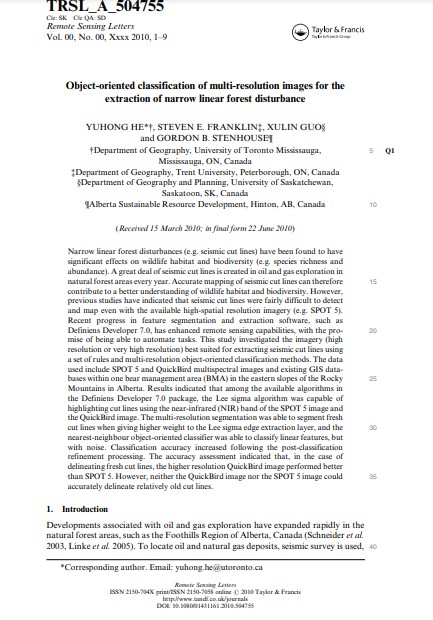Object-oriented classification of multi-resolution images for the extraction of narrow linear forest disturbance
Bosque Modelo:
Foothills
Temática:
Gestión forestal
Tipo de documento:
Artículo científico
Resumen
Narrow linear forest disturbances (e.g. seismic cut lines) have been found to have significant effects on wildlife habitat and biodiversity (e.g. species richness and abundance). A great deal of seismic cut lines is created in oil and gas exploration in natural forest areas every year. Accurate mapping of seismic cut lines can therefore contribute to a better understanding of wildlife habitat and biodiversity. However, previous studies have indicated that seismic cut lines were fairly difficult to detect and map even with the available high-spatial resolution imagery (e.g. SPOT 5). Recent progress in feature segmentation and extraction software, such as Definiens Developer 7.0, has enhanced remote sensing capabilities, with the promise of being able to automate tasks. This study investigated the imagery (high resolution or very high resolution) best suited for extracting seismic cut lines using a set of rules and multi-resolution object-oriented classification methods. The data used include SPOT 5 and QuickBird multispectral images and existing GIS databases within one bear management area (BMA) in the eastern slopes of the Rocky Mountains in Alberta. Results indicated that among the available algorithms in the Definiens Developer 7.0 package, the Lee sigma algorithm was capable of highlighting cut lines using the near-infrared (NIR) band of the SPOT 5 image and the QuickBird image. The multi-resolution segmentation was able to segment fresh cut lines when giving higher weight to the Lee sigma edge extraction layer, and the nearest-neighbour object-oriented classifier was able to classify linear features, but with noise. Classification accuracy increased following the post-classification refinement processing. The accuracy assessment indicated that, in the case of delineating fresh cut lines, the higher resolution QuickBird image performed better than SPOT 5. However, neither the QuickBird image nor the SPOT 5 image could accurately delineate relatively old cut lines.
Información Bibliográfica
Autor:
He, Y., Franklin, S.E., Guo, X., & Stenhouse, G.B.
Revista:
Remote Sensing Letters
Año:
2011
N°:
00
País :
Canadá
Páginas:
147 - 155
Volumen:
00
Idioma:
Ingles
Palabras claves
Model forest, Adaptatation





